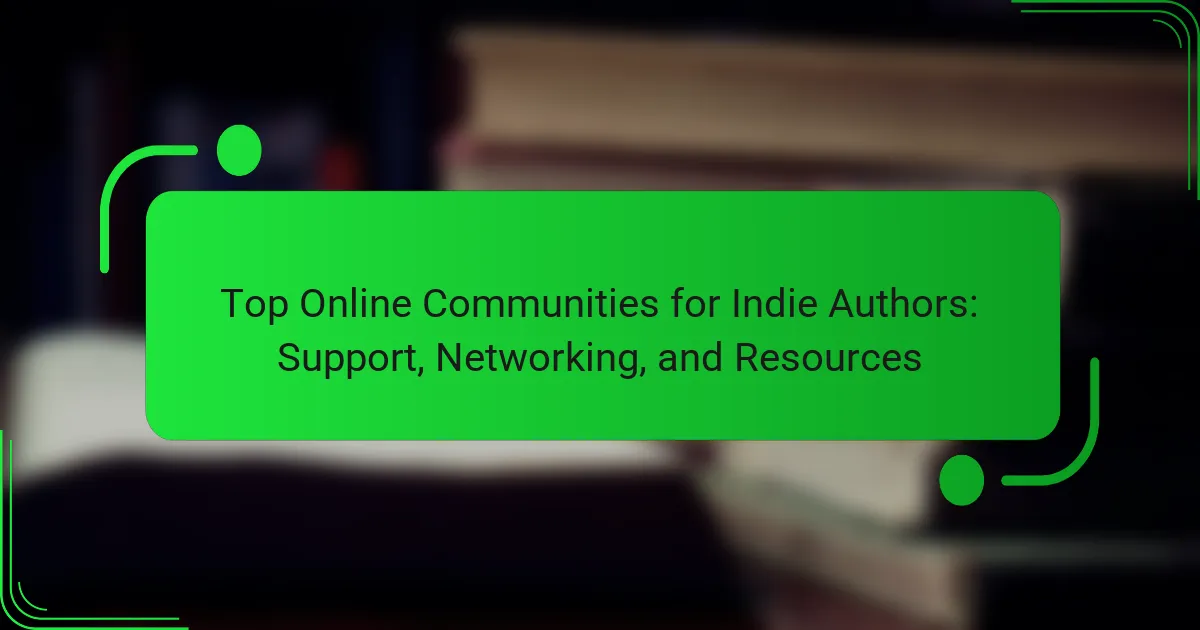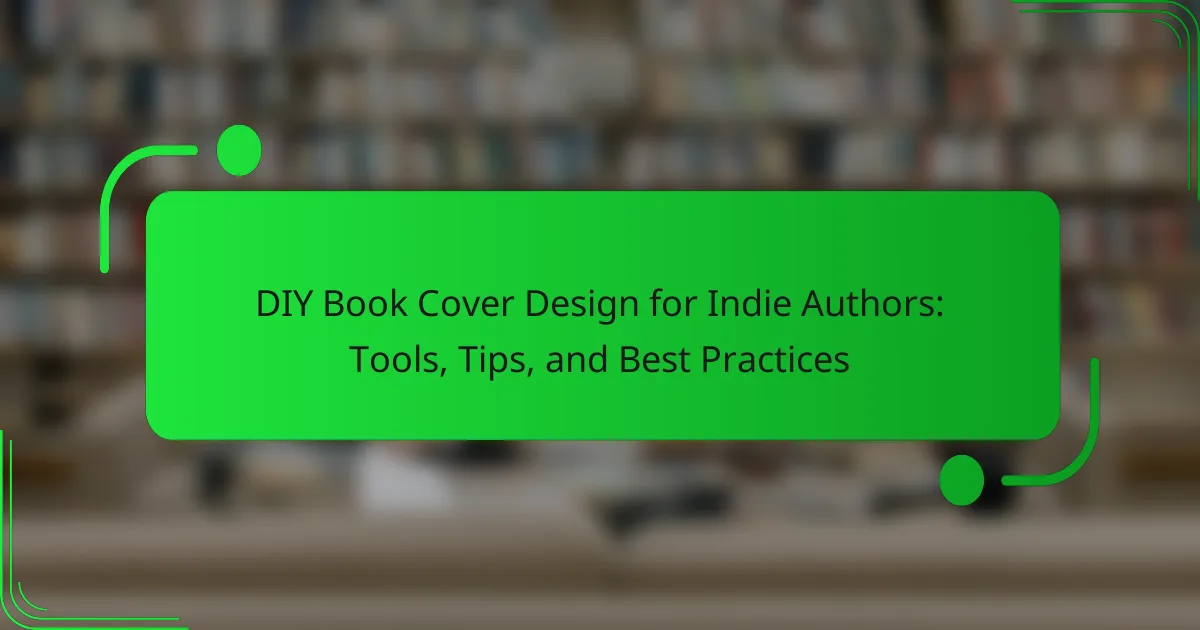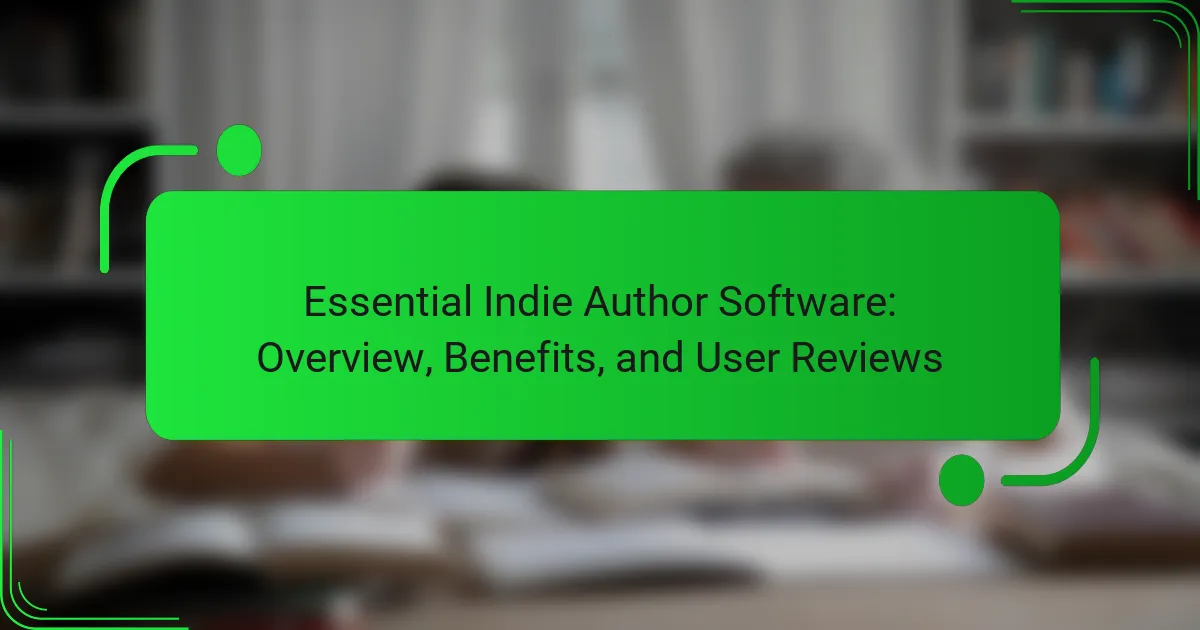Indie authors often struggle with visibility and engagement on social media. Effective strategies include selecting the right platforms like Instagram and Twitter, creating diverse content types, and fostering audience interaction. Key content formats include visual posts, behind-the-scenes insights, and interactive stories. Tracking engagement metrics helps refine approaches for sustained success.
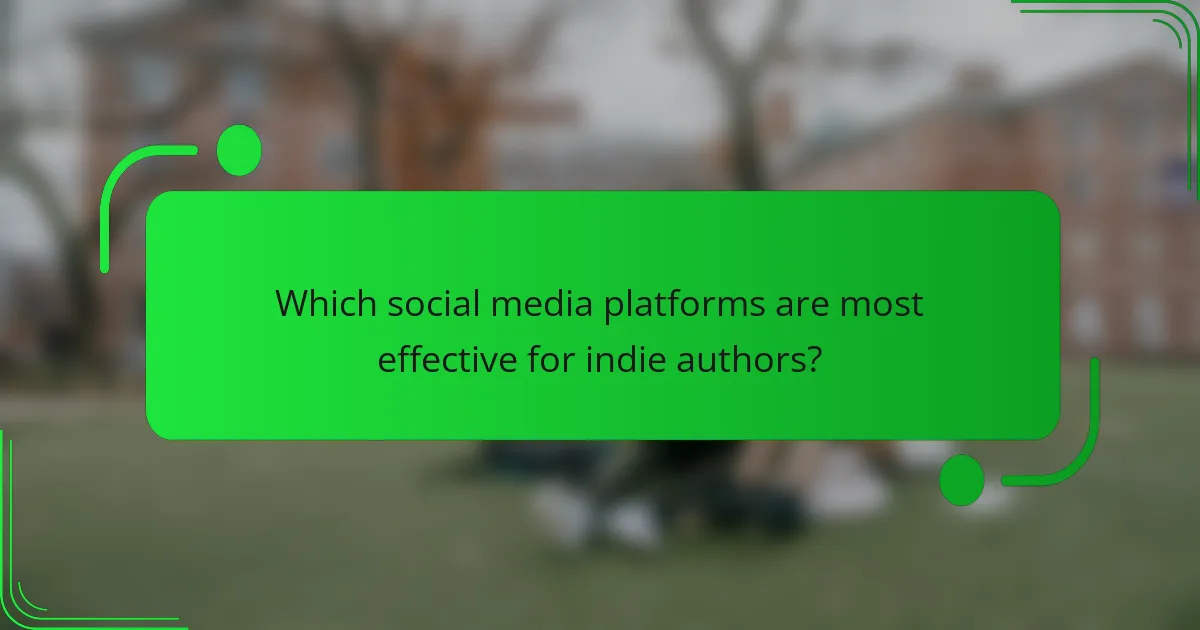
Which social media platforms are most effective for indie authors?
Indie authors find platforms like Instagram, Twitter, and Facebook most effective for building an audience. Instagram’s visual focus attracts readers, while Twitter facilitates quick interactions. Facebook groups foster community engagement. Each platform offers unique opportunities for content sharing and audience connection.
How does audience engagement differ across platforms?
Audience engagement varies significantly across social media platforms. Each platform attracts different demographics and encourages unique interaction styles.
On Facebook, engagement thrives on community building and discussions. Posts with visuals garner higher interaction rates, with videos being particularly effective. Twitter favors quick interactions, where concise updates and real-time conversations are key. Instagram relies heavily on visual storytelling, making high-quality images and reels essential for engagement. TikTok emphasizes creative, short-form video content, encouraging users to participate in trends. LinkedIn is more professional, where informative articles and networking posts drive engagement among industry professionals.
Understanding these differences helps indie authors tailor their content strategies to maximize audience engagement effectively.
What are the unique features of Instagram for book promotion?
Instagram offers unique features for book promotion, including visually engaging content, a vast audience reach, and interactive tools. The platform’s emphasis on imagery allows authors to showcase their book covers creatively. Instagram Stories and Reels enable real-time engagement, fostering a connection with followers. Hashtags enhance discoverability, allowing authors to reach niche audiences. Additionally, Instagram Live facilitates direct interaction, where authors can host Q&A sessions or readings. These features collectively enhance an indie author’s visibility and engagement with potential readers.
Why is Twitter essential for real-time interactions?
Twitter is essential for real-time interactions because it facilitates immediate communication and engagement. The platform’s character limit encourages concise messaging, making it ideal for quick updates and responses. Authors can share thoughts, promote their work, and connect with readers instantly. Additionally, trending topics allow indie authors to join conversations and reach wider audiences. The fast-paced nature of Twitter fosters community building and enhances visibility, making it a key tool for real-time author-reader interactions.
Which platforms cater to specific genres or audiences?
Several social media platforms cater to specific genres and audiences, enhancing engagement for indie authors.
Facebook is ideal for community building and genre-specific groups, while Instagram thrives on visual storytelling, making it suitable for authors with strong imagery. Twitter is effective for real-time interaction and updates, appealing to diverse audiences. TikTok has gained traction with younger readers through creative video content, especially for genres like fantasy and romance. Goodreads serves avid readers, offering a niche for book discussions and reviews.
Choosing the right platform can amplify an author’s reach and foster deeper connections with their target audience.

What types of content should indie authors create?
Indie authors should create diverse content across various platforms to engage readers effectively. Focus on visual posts, behind-the-scenes insights, and interactive stories to build a connection.
1. Visual Posts: Share book covers, illustrations, and quotes to attract attention.
2. Behind-the-Scenes: Provide insights into the writing process and personal anecdotes to humanize the author.
3. Interactive Stories: Use polls, questions, and live sessions to engage the audience directly.
4. Blog Posts: Write articles related to book themes or writing tips to establish authority.
5. Video Content: Create book trailers or author vlogs to reach a wider audience.
6. Reader Engagement: Host giveaways or Q&A sessions to foster community interaction.
How can visual content enhance book visibility?
Visual content significantly enhances book visibility by attracting attention and increasing engagement on social media platforms. High-quality images, videos, and graphics can effectively showcase a book’s cover, themes, and unique attributes, making it more appealing to potential readers. For instance, posts featuring captivating visuals receive up to 94% more views than text-only content. Engaging visual content can drive shares and interactions, amplifying an indie author’s reach. As a result, authors can build a stronger online presence, connect with their audience, and ultimately boost book sales.
What role do videos play in engaging readers?
Videos significantly enhance reader engagement by providing dynamic content that captures attention. They facilitate storytelling, making complex ideas more digestible. Additionally, videos can increase shareability on social media platforms, leading to wider audience reach. Studies show that posts with videos receive 48% more views than those without, underscoring their effectiveness in engaging readers.
Why are behind-the-scenes posts important for audience connection?
Behind-the-scenes posts are crucial for fostering audience connection as they humanize the author and create authenticity. These posts provide insights into the creative process, making audiences feel more engaged and involved. Sharing personal stories or challenges can resonate deeply, encouraging a sense of community. This connection often leads to increased loyalty and support from readers.
Which written content formats drive the most engagement?
Visual content formats, particularly images and videos, drive the most engagement on social media. These formats capture attention quickly and encourage shares and comments.
Research indicates that posts with images receive 650% higher engagement than text-only posts. Videos can increase engagement rates by up to 1200%. Additionally, stories on platforms like Instagram and Facebook create a sense of urgency, leading to higher interaction levels.
Incorporating user-generated content can also enhance engagement. This approach fosters community and trust, making followers more likely to interact. Consistent posting of diverse content types, including polls and live sessions, maintains audience interest and boosts overall engagement.
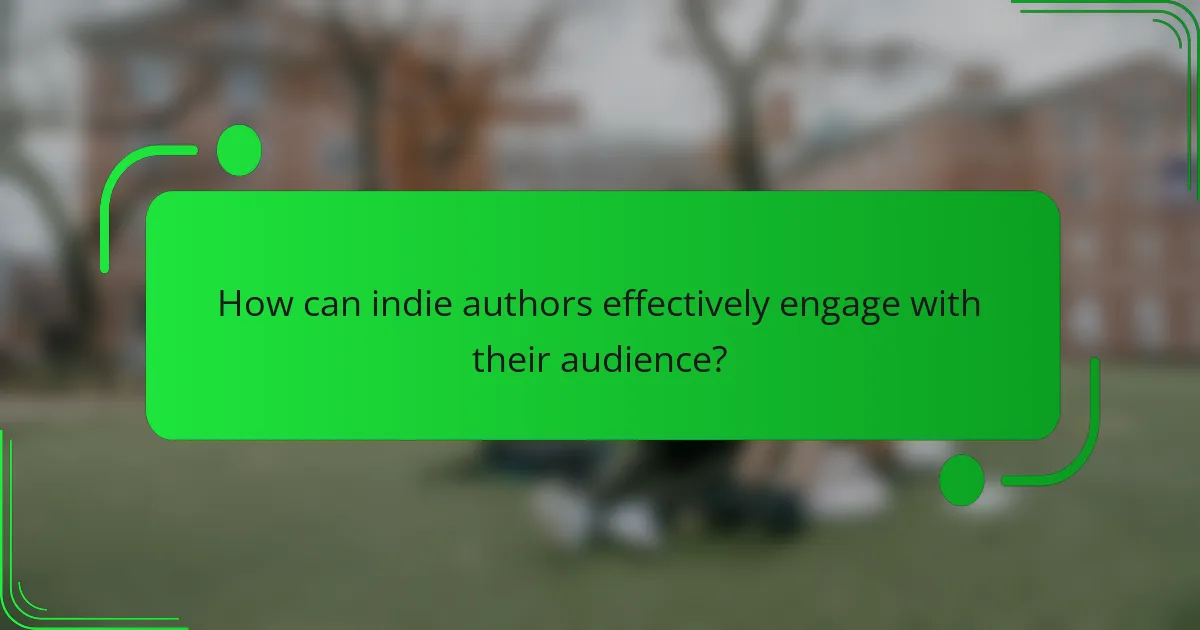
How can indie authors effectively engage with their audience?
Indie authors can effectively engage with their audience by utilizing targeted social media strategies. Focus on platforms like Instagram, Twitter, and Facebook to connect with readers.
1. Identify your audience demographics to choose the right platforms.
2. Share diverse content types such as behind-the-scenes looks, writing tips, and book excerpts.
3. Foster engagement by responding to comments and hosting Q&A sessions.
4. Collaborate with other authors or influencers to expand reach.
5. Utilize analytics tools to track engagement and adjust strategies accordingly.
What strategies foster community building among readers?
Engaging with readers through social media builds a strong community. Focus on authentic interactions, regular content updates, and collaborative projects.
Utilize platforms like Instagram and Twitter for visual storytelling and real-time engagement. Share behind-the-scenes content to foster connection.
Encourage reader participation through polls, Q&A sessions, and user-generated content. This promotes a sense of belonging and investment in your work.
Join relevant groups and forums to expand your reach and connect with like-minded individuals. This creates opportunities for discussions and feedback.
How important is responding to comments and messages?
Responding to comments and messages is crucial for indie authors to build engagement and foster community. Active interaction enhances visibility and establishes a loyal reader base. Engaging with followers signals that their opinions matter, which can lead to increased sharing of content and positive word-of-mouth. Additionally, timely responses can provide valuable feedback on content and marketing strategies, helping authors refine their approach. This engagement is a unique attribute that distinguishes successful authors in a competitive landscape.
What are the benefits of hosting live Q&A sessions?
Hosting live Q&A sessions offers significant benefits for indie authors. These sessions enhance audience engagement, foster community building, and provide real-time feedback. Authors can address specific reader questions, showcasing expertise and authenticity. Additionally, live interactions can boost visibility on social media platforms, driving traffic to their work.
Which engagement techniques boost follower loyalty?
Engagement techniques that boost follower loyalty include consistent interaction, personalized content, and community building. Regularly responding to comments fosters a sense of connection. Tailoring posts to audience preferences increases relevance. Creating a community space encourages followers to engage with each other, enhancing loyalty.
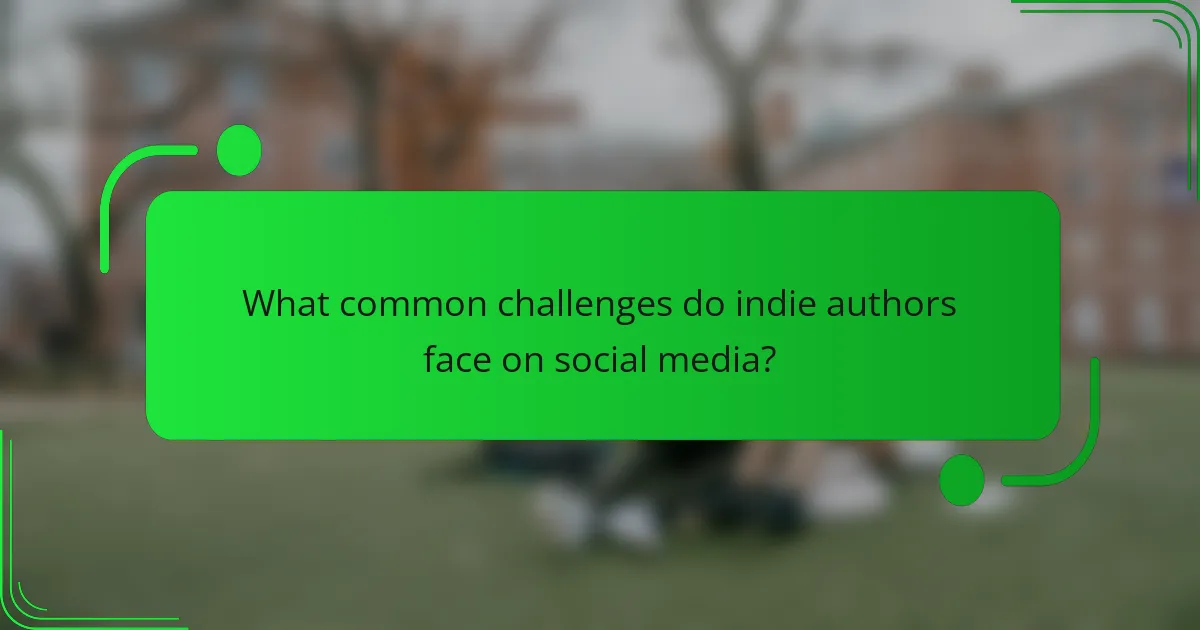
What common challenges do indie authors face on social media?
Indie authors face several common challenges on social media, including limited visibility, audience engagement, and content creation. Limited visibility arises from algorithm changes that affect post reach. Authors often struggle to engage followers consistently, leading to stagnant growth. Additionally, creating diverse and appealing content can be daunting without adequate resources or marketing knowledge.
How can authors combat negative feedback or criticism?
Authors can combat negative feedback by actively engaging with their audience and focusing on constructive criticism. Building a supportive community on social media platforms allows authors to share experiences and insights. Responding positively to feedback demonstrates professionalism and resilience. Sharing personal stories of overcoming criticism can further connect with readers. Additionally, using analytics to understand audience preferences helps tailor content that resonates positively, minimizing negative reactions.
What strategies help manage time spent on social media?
To manage time spent on social media, indie authors should set specific time limits, use scheduling tools, and engage in focused content creation. Prioritize platforms that yield the best engagement. Regularly assess analytics to refine strategies and eliminate distractions.
How can indie authors navigate algorithm changes?
Indie authors can navigate algorithm changes by adapting their social media strategies. Focus on diverse content types, such as videos, infographics, and live sessions, to maintain engagement. Monitor platform analytics to understand shifting audience preferences and adjust posting schedules accordingly. Engage authentically with followers through comments and direct messages to build community. Stay informed about algorithm updates and best practices by following industry experts and participating in relevant forums.

What metrics should indie authors track for success?
Indie authors should track engagement metrics, follower growth, content reach, and conversion rates. These metrics provide insights into audience interaction and overall effectiveness of social media strategies.
Engagement metrics include likes, shares, and comments, which indicate how well content resonates. Follower growth shows audience expansion, while content reach assesses visibility. Tracking conversion rates measures how many followers take desired actions, such as purchasing a book.
Regularly analyzing these metrics helps indie authors refine their strategies, ensuring sustained success in a competitive landscape.
Which engagement metrics are most telling of audience interest?
Engagement metrics that indicate audience interest include likes, shares, comments, and click-through rates. These metrics provide insights into how well content resonates with readers. For indie authors, tracking these metrics helps refine social media strategies. High engagement rates often correlate with increased visibility and audience growth.
How do authors measure the effectiveness of their content?
Authors measure the effectiveness of their content through engagement metrics and audience feedback. Key indicators include likes, shares, comments, and follower growth on social media platforms. Tracking these metrics helps authors understand which content resonates with their audience. Additionally, analyzing website traffic and conversion rates provides insights into content performance. Unique attributes like the type of content shared, such as videos or blog posts, can also influence engagement levels. Regularly assessing these factors allows authors to refine their social media strategies effectively.
What tools can assist in tracking social media performance?
Analytics tools like Hootsuite, Buffer, and Sprout Social can effectively track social media performance. These platforms provide insights on engagement metrics, audience growth, and content effectiveness. They enable indie authors to analyze which posts resonate best with their audience, optimizing future content strategies. Using these tools can enhance overall social media strategy, ensuring authors connect with their readers more effectively.

How can indie authors optimize their social media strategies?
Indie authors can optimize their social media strategies by focusing on platform selection, content types, and engagement techniques. Prioritize platforms like Instagram and Twitter, which cater to visual storytelling and quick updates. Create diverse content, including behind-the-scenes posts, book teasers, and reader polls to maintain interest. Engage actively with followers through comments and direct messages to foster a community. Consistency in posting schedules and authentic interactions enhances visibility and reader loyalty.
What are the best practices for creating a content calendar?
To create an effective content calendar, indie authors should prioritize consistency, audience engagement, and strategic planning. Start by defining your goals, such as increasing followers or promoting new releases. Identify key platforms like Instagram, Twitter, and Facebook that align with your target audience.
Next, outline content types, including promotional posts, behind-the-scenes insights, and reader interaction prompts. Schedule posts at optimal times for engagement, using tools like Buffer or Hootsuite for automation. Regularly review analytics to adjust strategies based on performance metrics.
Finally, remain flexible to incorporate trending topics or reader feedback, ensuring your content stays relevant and engaging.
How can authors leverage analytics for content improvement?
Authors can leverage analytics to enhance their content by tracking engagement, understanding audience preferences, and optimizing strategies. Analytics tools provide insights into which content resonates most, allowing authors to adjust their messaging and platforms accordingly.
For instance, monitoring metrics such as likes, shares, and comments can reveal popular content types. This data enables authors to focus on formats that drive engagement, such as videos or infographics. Additionally, analyzing audience demographics helps tailor content to specific groups, increasing relevance and connection.
Engagement rates across different social media platforms can guide authors in selecting the most effective channels for their target audience. By regularly reviewing analytics, authors can refine their content strategies, ensuring they meet audience needs and preferences effectively.
What are common mistakes to avoid in social media marketing?
Common mistakes in social media marketing include inconsistent branding, neglecting audience engagement, and failing to analyze performance metrics. Indie authors should ensure their branding is uniform across platforms to build recognition. Engaging with followers fosters community and loyalty, which is crucial for success. Regularly reviewing analytics helps refine strategies and improve content effectiveness.
Which expert tips can enhance engagement and visibility?
To enhance engagement and visibility, indie authors should focus on authentic interactions and consistent content. Utilize storytelling techniques to connect with readers emotionally. Leverage platform-specific features like Instagram stories or Twitter polls to encourage audience participation. Additionally, analyze engagement metrics to refine strategies effectively.
